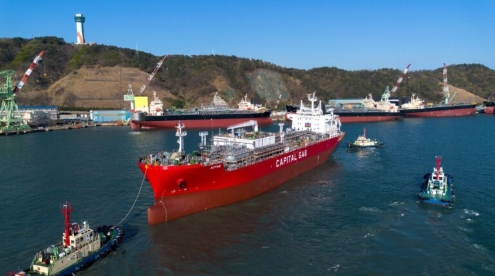
The vessel measures 159.9 meters in length, 27.4 meters in width, and 17.8 meters in height. It features three bi-lobe storage tanks designed to maintain a low temperature of -55°C and high pressure, five times that of atmospheric levels. This enables the ship to transport various liquefied gases, including LCO2, liquefied petroleum gas (LPG), and ammonia. “Our advanced tank design ensures safe and efficient transport of liquefied gases, supporting the global transition to cleaner energy solutions,” said a representative from HD Hyundai Mipo.
Equipped with eco-friendly technologies, the carrier includes a 2,500 kW land-based power supply unit and a nitrogen oxide reduction device to minimize emissions of air pollutants, such as fine dust and sulfur oxides. The ship is also ammonia-ready and incorporates ice-resistant design technology (Ice Class 1C) for enhanced operational versatility. Following final assembly and sea trials, the vessel is slated for delivery by the end of 2025.
Capital Clean Energy Carriers placed orders for the four 22,000 cbm LCO2 carriers between July 2023 and January 2024, with construction of the first unit beginning in August 2024. The remaining three vessels are expected to be delivered by the second half of 2026. “We are committed to expanding our fleet with innovative vessels to meet the growing demand for sustainable energy transport,” said a spokesperson from Capital Clean Energy Carriers.
In a related development, Capital Product Partners L.P. (CPLP), an affiliate of the shipping company, announced in June 2024 a $756 million investment in ten additional LCO2 and LPG/ammonia carriers. This includes six dual-fuel medium gas carriers and four LCO2 handy multi-gas carriers, to be built by shipyards in South Korea and China, with deliveries scheduled between early 2026 and mid-2027.
This project underscores the maritime industry’s focus on sustainable energy transport, with advanced vessels designed to support global environmental goals while maintaining operational efficiency.